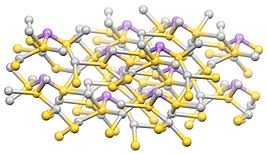Sulfosalt mineral
Appearance
(Redirected fromSulfosalt)

Sulfosalt mineralsaresulfide mineralswith the general formulaAmBnXp,where
- A represents ametalsuch ascopper,lead,silver,iron,and rarelymercury,zinc,vanadium
- B usually representssemi-metalsuch asarsenic,antimony,bismuth,and rarelygermanium,or metals liketinand rarelyvanadium
- X issulfuror rarelyseleniumand/ortellurium.[1]
TheStrunz classificationincludes the sulfosalts in asulfides and sulfosaltssuperclass.[1]A group which have similar appearing formulas are thesulfarsenides(for examplecobaltite(Co,Fe)AsS). In sulfarsenides the arsenic substitutes forsulfideanionswhereas in the sulfosalts the arsenic substitutes for a metalcation.[2]
About 200 sulfosalt minerals are known. Examples include:[3]
-
As illustrated by this specimen ofproustite,sulfosalt minerals are often deeply colored.
- A3BX3type
- PyrargyriteAg3SbS3
- ProustiteAg3AsS3
- TetrahedriteCu12Sb4S13
- TennantiteCu12As4S13
- A3BX4type
- EnargiteCu3AsS4
- SulvaniteCu3VS4
- SamsoniteAg4MnSb2S6
- GeocronitePb14(Sb,As)6S23
- GratonitePb9As4S15
- A2BX3type
- BournonitePbCuSbS3
- SeligmannitePbCuAsS3
- AikinitePbCuBiS3
- ABX2type
- BoulangeritePb5Sb4S11
- MatilditeAgBiS2
- SmithiteAgAsS2
- ChalcostibiteCuSbS2
- EmplectiteCuBiS2
- TeallitePbSnS2
- A2B2X5type
- RamdohriteAg3Pb6Sb11S24
- JamesonitePb4FeSb6S14
- CosalitePb2Bi2S5
- A2B3X6type
- AndoritePbAgSb3S6
- LindstromitePb3Cu3Bi7S15
- AB2X4type
- ZinkenitePb9Sb22S42
- BerthieriteFeSb2S4
- CylindritePb3Sn4FeSb2S14
Nickel–Strunz Classification -02- Sulfosalts
[edit]IMA-CNMNC proposes a new hierarchical scheme (Mills et al., 2009). This list uses theClassification of Nickel–Strunz(mindat.org,10 ed, pending publication).
- Abbreviations:
- "*" – discredited (IMA/CNMNC status).
- "?"– questionable/doubtful (IMA/CNMNC status).
- "REE" –Rare-earth element(Sc, Y, La, Ce, Pr, Nd, Pm, Sm, Eu, Gd, Tb, Dy, Ho, Er, Tm, Yb, Lu)
- "PGE" –Platinum-group element(Ru, Rh, Pd, Os, Ir, Pt)
- 03.C Aluminofluorides, 06 Borates, 08 Vanadates (04.H V[5,6]Vanadates), 09 Silicates:
- Neso: insular (fromGreekνῆσοςnēsos,island)
- Soro: grouping (fromGreekσωρόςsōros,heap, mound (especially of corn))
- Cyclo: ring (fromGreekκύκλοςkyklos,wheel, ring, round)
- Ino: chain (fromGreekἴς [genitive: ἰνόςinos], fibre)
- Phyllo: sheet (fromGreekφύλλονphyllon,leaf)
- Tekto: three-dimensional framework (fromGreekstem τεκτ-tekt-in words having to do with carpentry)
- Nickel–Strunz code scheme: NN.XY.##x
- NN: Nickel–Strunz mineral class number
- X: Nickel–Strunz mineral division letter
- Y: Nickel–Strunz mineral family letter
- ##x: Nickel–Strunz mineral/group number, x add-on letter
Class: sulfosalts
[edit]- 02.G Sulfarsenites, sulfantimonites, sulfobismuthites
- 02.G: IMA2007-010
- 02.GA Neso-sulfarsenites, etc., without additional S: 05Proustite,05Pyrargyrite;10Xanthoconite,10Pyrostilpnite;15Samsonite;20Wittichenite,20Skinnerite,25Malyshevite,25Lisiguangite,25Muckeite,25Lapieite;30Aktashite,30Nowackiite,30Gruzdevite;35Laffittite;40Stalderite,40Routhierite;45Erniggliite;50Seligmannite,50Soucekite,50Bournonite
- 02.GB Neso-sulfarsenites, etc.: 05Argentotennantite,05Giraudite,05Goldfieldite,05Freibergite,05Hakite,05Tennantite,05Tetrahedrite;10Selenostephanite,10Stephanite;15Cupropearceite,15Selenopolybasite,15Cupropolybasite,15Polybasite,15Pearceite,15Antimonpearceite,15Arsenpolybasite,20Galkhaite
- 02.GC Poly-sulfarsenites: 05Hatchite,05Wallisite;10Sinnerite,15Watanabeite,20Simonite,25Qratite,30Smithite,35Trechmannite,40aAleksite,40bKochkarite,40cRucklidgeite,40cPoubaite,40dSaddlebackite,40eBabkinite;45Tvalchrelidzeite,50Mutnovskite
- 02.H Sulfosalts of SnS Archetype
- 02.HA With Cu, Ag, Fe (without Pb): 05Emplectite,05Chalcostibite;10Miargyrite,15Livingstonite;20Berthierite,20Clerite,20Garavellite;25Baumstarkite,25Aramayoite
- 02.HB With Cu, Ag, Hg, Fe, Sn and Pb: 05aKrupkaite,05aAikinite,05aHammarite,05aGladite,05aFriedrichite,05aLindstromite,05aPekoite,05aPaarite,05aEmilite,05aSalzburgite,05bMeneghinite,05cJaskolskiite;10aKobellite,10aTintinaite,10bGiessenite,10bIzoklakeite,10cEclarite;15Jamesonite,15Benavidesite;20aNagyagite,20bBuckhornite,20cMuseumite,20dBerryite,20eWatkinsonite
- 02.HC With only Pb: 05aSartorite,05aTwinnite,05aGuettardite,05bBaumhauerite,05b Baumhauerite-2a, 05cLiveingite,05dDufrenoysite,05dVeenite,05dRathite,05eChabourneite,05fPierrotite,05fParapierrotite,05gMarumoite;10aFuloppite,10bBismutoplagionite*, 10bPlagionite,10cHeteromorphite,10dSemseyite,10dRayite;15Boulangerite,15Falkmanite,15Plumosite*; 20Robinsonite,25Moeloite,30Dadsonite,35Zoubekite,35Owyheeite
- 02.HD With Tl: 05Lorandite,05Weissbergite;15Christite,20Jankovicite,25Rebulite,30Imhofite,35Edenharterite,40Jentschite,45Hutchinsonite,50Bernardite,55Sicherite,60Gabrielite
- 02.HE With alkalies,H2O:05Gerstleyite
- 02.HF With SnS and PbS archetype structure units: 20Vrbaite;25aAbramovite,25aLevyclaudite,25aCylindrite,25bCoiraite,25bIncaite,25bPotosiite,25bFranckeite;30Lengenbachite
- 02.J Sulfosalts of PbS Archetype
- 02.JA Galena derivatives with little or no Pb: 05a IMA2005-036, 05a IMA2008-058, 05aCupropavonite,05aPavonite,05bGrumiplucite,05cKudriavite,05dCupromakovickyite,05dMakovickyite,05eBenjaminite,05fMummeite,05gBorodaevite,05hMozgovaite;10aCuprobismutite,10bKupcikite,10cHodrushite,10dPizgrischite,10ePaderaite;15Cuboargyrite,15Schapbachite;20Bohdanowiczite,20Matildite,20Volynskite
- 02.JB Galena derivatives, with Pb: 05Diaphorite,10Cosalite;15Marrite,15Freieslebenite;20Cannizzarite,20Wittite;25aJunoite,25bFelbertalite,25cNordstromite,25dProudite,25gNuffieldite,25i IMA2008-053, 25iNeyite,25jRouxelite;30aJordanite,30aGeocronite,30bKirkiite,30cTsugaruite;35aZinkenite,35bScainiite,35cPillaite,35dPellouxite;40aBursaite?, 40aGustavite,40aLillianite,40aXilingolite,40aTreasurite,40aVikingite,40aFizelyite,40aAndorite,40aRoshchinite,40aUchucchacuaite,40aRamdohrite,40bAschamalmite,40bEskimoite,40bHeyrovskyite,40cOurayite,40dSchirmerite,40eUstarasite;45Angelaite,45Galenobismutite,45Weibullite;55Gratonite,60Marrucciite,65Vurroite
- 02.JC Galena derivatives, with Tl: 05Ellisite,10Gillulyite
- 02.K Sulfarsenates, Sulfantimonates
- 02.KA Sulfarsenates with(As,Sb)S4tetrahedra: 05Enargite,05Stibioenargite*, 05Petrukite;10Briartite,10Famatinite,10Luzonite,10Permingeatite,10Barquillite;15Fangite
- 02.KB Sulfarsenates with additional S: 05Billingsleyite
- 02.L Unclassified Sulfosalts
- 02.LA Without essential Pb: 10Dervillite,15Daomanite*, 20Vaughanite,25Criddleite,30Fettelite,35Chameanite,40Arcubisite,45Mgriite,50Benleonardite,55Tsnigriite,60Borovskite,65Jonassonite
- 02.LB With essential Pb: 05Miharaite,20Ardaite,30Madocite,35Larosite;40Petrovicite,40Mazzettiite;45Crerarite,50Launayite,55Playfairite,60Sorbyite,65Sterryite
- 02.M
- 02.MA Oxysulfosalts of Alkalies and Alkali Earths: 05Ottensite,05Cetineite;10Sarabauite
- 02.X Unclassified Strunz Sulfosalts
- 02.XX Unknown: 00Tazieffite,00Horobetsuite*, 00Kitaibelite?, 00Parajamesonite?, 00Sakharovaite?, 00Volfsonite*
Synthetic sulfosalts
[edit]Many sulfosalts can be prepared in the laboratory, including many that do not occur in nature.[4][which?]
References
[edit]- ^ab"Strunz classification of sulfides and sulfosalts".Mindat.
- ^Klein, Cornelis and Cornelius S. Hurlbut (1985).Manual of Mineralogy,20th ed., John Wiley and Sons, New YorkISBN0-471-80580-7.
- ^Palache, C., H. Berman, and C. Frondel (1944). Dana’s System of Mineralogy, (7th edition), v. I, pp. 348–350
- ^Sheldrick, William S.; Wachhold, Michael "Chalcogenidometalates of the heavier Group 14 and 15 elements" Coordination Chemistry Reviews 1998, vol. 176, 211–322.doi:10.1016/S0010-8545(98)00120-9
- Mozgova N.N. (2000).Sulfosalt mineralogy today.In:Modern Approaches to Ore and Environmental Mineralogy,MSF Mini-Symposium Espoo Finland, June 11–17, 2000,https://web.archive.org/web/20050907172937/http:// igem.ru/igem/mine/sulfosalts.htmRetrieved July 22, 2005.
- Moëlo, Yves;Makovicky, Emil; Mozgova, Nadejda N.; Jambor, John L.; Cook, Nigel; Pring, Allan; Paar, Werner;Nickel, Ernest H.;et al. (2008)."Sulfosalt systematics: a review. Report of the sulfosalt sub-committee of the IMA Commission on Ore Mineralogy"(PDF).European Journal of Mineralogy.20(1): 7.doi:10.1127/0935-1221/2008/0020-1778.
- Stuart J. Mills; Frédéric Hatert; Ernest H. Nickel & Giovanni Ferraris (2009)."The standardisation of mineral group hierarchies: application to recent nomenclature proposals"(PDF).Eur. J. Mineral.21(5): 1073–1080.doi:10.1127/0935-1221/2009/0021-1994.
- Ernest H. Nickel & Monte C. Nichols (March 2009)."IMA-CNMNC List of Mineral Names"(PDF).IMA-CNMNC.
- Ferraiolo, Jim."Nickel–Strunz (Version 10) Classification System".webmineral.

